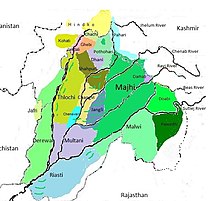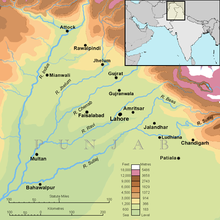ชาวปัญจาบ
پنجابی ਪੰਜਾਬੀ | |
|---|---|
 | |
| ประชากรทั้งหมด | |
| ประมาณ 150 ล้านคน[1][2][3][4] | |
| ภูมิภาคที่มีประชากรอย่างมีนัยสำคัญ | |
| 108,586,959 (2022)[a][6][7][8] | |
| 37,520,211 (2022)[b][3][c][10] | |
| 942,170 (2021)[11][d] | |
| 700,000 (2006)[12] | |
| 253,740[13] | |
| 132,496 (2017)[14] | |
| 56,400 (2019)[15] | |
| 50,000 (2016)[16] | |
| 34,227 (2018)[17] | |
| 24,000 (2013)[18] | |
| 23,700 (2019)[19] | |
| 18,000 (2020)[20] | |
| 10,000 (2019)[21] | |
| อื่น ๆ | ดุชาวปัญจาบพลัดถิ่น |
| ภาษา | |
| ส่วนใหญ่: ภาษาปัญจาบและภาษาย่อย ส่วนน้อย: ภาษาอูรดู (ในปากีสถาน) และภาษาฮินดี (ในอินเดีย) | |
| ศาสนา | |
| ส่วนใหญ่ ส่วนน้อย ปัญจาบฝั่งปากีสถาน: ส่วนใหญ่ ส่วนน้อย ปัญจาบฝั่งอินเดีย: ส่วนใหญ่ ส่วนน้อย | |
| กลุ่มชาติพันธุ์ที่เกี่ยวข้อง | |
| กลุ่มชนอินโด-อารยันอื่น ๆ | |
ชาวปัญจาบ (ปัญจาบ: پنجابی (ชาห์มุขี); ਪੰਜਾਬੀ (คุรมุขี)) เป็นกลุ่มชาติพันธุ์-ภาษาอินโด-อารยัน[25]ที่มีความเกี่ยวข้องกับภูมิภาคปัญจาบในอนุทวีปอินเดีย ประกอบด้วยปากีสถานตะวันออก และอินเดียตะวันตกเฉียงเหนือ[26] ประชากรทั้งสองประเทศพูดภาษาปัญจาบมาตรฐานหรือภาษาย่อยปัญจาบหลายภาษา[27]
ชื่อเรียกชาติพันธุ์มาจากคำว่า Punjab (ห้าแม่น้ำ) ในภาษาเปอร์เซีย เพื่อสื่อถึงพื้นที่ทางภูมิศาสตร์ทางตะวันตกเฉียงเหนือของอนุทวีปอินเดีย ซึ่งมีแม่น้ำทั้ง 5 (บีอาส, จนาพ, เฌลัม, ราวี และสตลุช) ไหลลงไปรวมในแม่น้ำสินธุ[28][29][30] กับแม่น้ำ Ghaggar ที่แห้งขอดแล้ว[31]
การรวมตัวกันของชนเผ่าต่าง ๆ วรรณะทางสังคม และผู้อยู่อาศัยในภูมิภาคปัญจาบก่อให้เกิดอัตลักษณ์ "ปัญจาบ" แบบทั่วไปตั้งแต่ต้นคริสต์ศตวรรษที่ 18[32][33][34] ในอดีต ชาวปัญจาบเป็นกลุ่มวิวิธพันธุ์ (heterogeneous) และแบ่งออกเป็นกลุ่มตระกูลที่มีชื่อเรียกว่า biradari (แปลว่า "ภราดรภาพ") หรือ เผ่า ที่แต่ละคนมีความผูกพัน ภายหลังโครงสร้างเผ่าถูกแทนที่ด้วยสังคมที่เหนียวแน่นและเป็นองค์รวมมากขึ้น เนื่องจากการสร้างชุมชนและความยึดเหนี่ยวของกลุ่มก่อให้เกิดเสาใหม่ของสังคมปัญจาบ[34][35]
เดิมที อัตลักษณ์ของชาวปัญจาบโดยหลักเป็นภาษา ภุมิศาสตร์ และวัฒนธรรม อัตลักษณ์เหล่านี้ไม่มีความเกี่ยวข้องกับต้นตอทางประวัติศาสตร์หรือศาสนา โดยกล่าวถึงผู้ที่อาศัยอยู่ในภูมิภาคปัญจาบหรือมีส่วนเกี่ยวข้องกับประชากรในภูมิภาคนี้ และผู้ที่ถือว่าภาษาปัญจาบเป็นภาษาแม่ของตน[36] การบูรณาการและการกลืนกลายเป็นส่วนสำคัญของวัฒนธรรมปัญจาบ เนื่องจากอัตลักษณ์ของชาวปัญจาบไม่ได้อิงกับความสัมพันธ์ทางชนเผ่าอย่างเดียว[37] ในขณะที่ชาวปัญจาบมีอาณาเขต เชื้อชาติ และภาษาร่วมกัน ก็มีบางส่วนที่อาจนับถือศาสนาอื่น ๆ ส่วนใหญ่นับถืออิสลาม, ฮินดู, ซิกข์ หรือคริสต์[38]
ศัพทมูลวิทยา
[แก้]ศัพท์ "ปัญจาบ" ปรากฏขึ้นในรัชสมัยจักรพรรดิอักบัรเมื่อปลายคริสต์ศตวรรษที่ 16[39][29][30] แม้ว่าศัพท์ปัญจาบมีต้นตอจากภาษาเปอร์เซีย คำทั้งสองคำนี้ (پنج, panj, 'ห้า' กับ آب, āb, 'น้ำ') เป็นคำร่วมเชื้อสายกับศัพท์ภาษาสันสกฤต (पञ्च, pañca, 'ห้า' กับ अप्, áp, 'น้ำ') ที่มีความหมายเดียวกัน[40][41] ดังนั้น คำว่า pañjāb จึงหมายถึง 'ดินแดนแห่งแม่น้ำทั้งห้า' ซึ่งสื่อถึงแม่น้ำเฌลัม จนาพ ราวี สตลุช และบีอาส[42] ทั้งหมดเป็นลำน้ำสาขาของแม่น้ำสินธุ โดยมีแม่น้ำสตลุชเป็นลำสาขาที่ใหญ่ที่สุด ข้อมูลที่อ้างอิงถึงดินแดนแห่งแม่น้ำทั้งห้าอาจพบในมหาภารตะ ซึ่งเรียกหนึ่งในภูมิภาคในภารัตโบราณว่า Panchanada (สันสกฤต: पञ्चनद, อักษรโรมัน: pañca-nada, แปลตรงตัว 'ห้าแม่น้ำ')[43][44] ชาวกรีกโบราณเรียกภูมิภาคนี้ว่า Pentapotamía (กรีก: Πενταποταμία)[45][46][47] ซึ่งมีความหมายเดียวกันกับศัพท์ภาษาเปอร์เซีย
ขอบเขตทางภูมิศาสตร์
[แก้]ปัญจาบเป็นภูมิภาคทางภูมิรัฐศาสตร์ วัฒนธรรม และประวัติศาสตร์ในเอเชียใต้ โดยเฉพาะในบริเวณทางตอนเหนือของอนุทวีปอินเดีย ซึ่งประกอบด้วยพื้นที่ทางตะวันออกของปากีสถานและทางตะวันตกเฉียงเหนือของอินเดีย ขอบเขตของภูมิภาคนั้นไม่ชัดเจนและมุ่งเน้นไปที่เรื่องราวทางประวัติศาสตร์ คำจำกัดความทางภูมิศาสตร์ของ "ปัญจาบ" ก็เปลี่ยนไปตามยุคสมัย โดยในสมัยจักรวรรดิโมกุลเมื่อคริสต์ศตวรรษที่ 16 ระบุถึงพื้นที่ค่อนข้างเล็กระหว่างแม่น้ำสินธุกับแม่น้ำสตลุช[48][39]

หมายเหตุ
[แก้]- ↑ ชาวปัญจาบอยู่ในจำนวนประชากรปากีสถาน 44.7% (108,586,959) จากประชากรทั้งหมด 242,923,845 คนตามจำนวนประมาณการของ World Factbook ใน ค.ศ. 2022[5]
- ↑ ชาวปัญจาบอยู่ในจำนวนประชากรอินเดีย 2.7% (37,520,211) จากประชากรทั้งหมด 1,389,637,446 คนตามจำนวนประมาณการของ World Factbook ใน ค.ศ. 2022[9]
- ↑ จำนวนนี้รวมผู้พูดภาษาปัญจาบในอินเดีย โดยไม่รวมผู้ที่มีเชื้อสายปัญจาบแต่ไม่พูดภาษานี้
- ↑ สถิตินี้รวมผู้พูดภาษาปัญจาบทั้งหมด ทั้งผู้พูดเป็นภาษาแม่ ภาษาที่สอง หรือภาษาที่สาม
อ้างอิง
[แก้]- ↑ https://www.worlddata.info/languages/punjabi.php#:~:text=The%20Punjabi%20language%20(native%20name,Punjabi%20as%20their%20mother%20tongue.
- ↑ ชาวปัญจาบ ที่ Ethnologue (21st ed., 2018)

- ↑ 3.0 3.1 "Abstract Of Speakers' Strength Of Languages And Mother Tongues - 2011" (PDF). Registrar General and Census Commissioner of India. คลังข้อมูลเก่าเก็บจากแหล่งเดิม (PDF)เมื่อ 20 February 2022. สืบค้นเมื่อ 12 June 2022.
- ↑ "Pakistan Census 2017" (PDF). www.pbs.pk. สืบค้นเมื่อ 20 September 2020.
- ↑ "South Asia :: Pakistan — The World Fact book - Central Intelligence Agency". www.cia.gov. สืบค้นเมื่อ 20 September 2020.
- ↑ "Ethnic Groups in Pakistan". Worldatlas.com. 30 July 2019.
Punjabi people are the ethnic majority in the Punjab region of Pakistan and Northern India accounting for 44.7% of the population in Pakistan.
- ↑ "Pakistan Census 2017" (PDF). www.pbs.pk. สืบค้นเมื่อ 20 September 2020.
- ↑ https://www.worlddata.info/languages/punjabi.php#:~:text=The%20Punjabi%20language%20(native%20name,Punjabi%20as%20their%20mother%20tongue
- ↑ "South Asia :: India — The World Fact book - Central Intelligence Agency". www.cia.gov. สืบค้นเมื่อ 8 May 2022.
- ↑ https://www.worlddata.info/languages/punjabi.php#:~:text=The%20Punjabi%20language%20(native%20name,Punjabi%20as%20their%20mother%20tongue
- ↑ Government of Canada, Statistics Canada (2022-08-17). "Census Profile, 2021 Census of Population Profile table Canada [Country]". www12.statcan.gc.ca. สืบค้นเมื่อ 2022-08-18.
- ↑ McDonnell, John (5 December 2006). "Punjabi Community". House of Commons. สืบค้นเมื่อ 3 August 2016.
We now estimate the Punjabi community at about 700,000, with Punjabi established as the second language certainly in London and possibly within the United Kingdom.
- ↑ "US Census Bureau American Community Survey (2009-2013) See Row #62". 2.census.gov.
- ↑ "Top ten languages spoken at home in Australia". คลังข้อมูลเก่าเก็บจากแหล่งเดิมเมื่อ 9 July 2017.
- ↑ "Malaysia". Ethnologue.com. สืบค้นเมื่อ 28 July 2019.
- ↑ "Punjabi community involved in money lending in Philippines braces for 'crackdown' by new President". 18 May 2016.
- ↑ "New Zealand". Stats New Zealand. สืบค้นเมื่อ 24 September 2019.
- ↑ Strazny, Philipp (1 February 2013). Encyclopedia of Linguistics. Routledge. ISBN 978-1-135-45522-4 – โดยทาง Google Books.
- ↑ "Bangladesh". Ethnologue.com. สืบค้นเมื่อ 28 July 2019.
- ↑ "Deutsche Informationszentrum für Sikhreligion, Sikhgeschichte, Kultur und Wissenschaft (DISR)". remid.de. สืบค้นเมื่อ 3 January 2020.
- ↑ "National Population and Housing Census 2011" (PDF). Unstats.unorg. สืบค้นเมื่อ 29 July 2019.
- ↑ "C-1 Population By Religious Community - 2011". คลังข้อมูลเก่าเก็บจากแหล่งเดิม (XLS)เมื่อ 23 September 2015. สืบค้นเมื่อ 29 July 2019.
- ↑ Wade Davis; K. David Harrison; Catherine Herbert Howell (2007). Book of Peoples of the World: A Guide to Cultures. National Geographic. pp. 132–133. ISBN 978-1-4262-0238-4.
- ↑ "Punjabis". Encyclopaedia.
- ↑ Goh, Daniel P. S.; Gabrielpillai, Matilda; Holden, Philip; Khoo, Gaik Cheng (12 June 2009). Race and Multiculturalism in Malaysia and Singapore (ภาษาอังกฤษ). Routledge. p. 187. ISBN 978-1-134-01649-5.
- ↑ Minahan, James (2012). Ethnic Groups of South Asia and the Pacific: An Encyclopedia (ภาษาอังกฤษ). ABC-CLIO. ISBN 978-1-59884-659-1.
- ↑ Concise Encyclopedia of Languages of the World. Elsevier. 2010. pp. 522–523. ISBN 978-0-08-087775-4.
- ↑ Nayar, Kamala Elizabeth (2012). The Punjabis in British Columbia: Location, Labour, First Nations, and Multiculturalism (ภาษาอังกฤษ). McGill-Queen's Press - MQUP. ISBN 978-0-7735-4070-5.
- ↑ 29.0 29.1 Gandhi, Rajmohan (2013). Punjab: A History from Aurangzeb to Mountbatten. New Delhi, India, Urbana, Illinois: Aleph Book Company. ISBN 978-93-83064-41-0.
- ↑ 30.0 30.1 Canfield, Robert L. (1991). Persia in Historical Perspective. Cambridge, United Kingdom: Cambridge University Press. p. 1 ("Origins"). ISBN 978-0-521-52291-5.
- ↑ West, Barbara A. (19 May 2010). Encyclopedia of the Peoples of Asia and Oceania (ภาษาอังกฤษ). Infobase Publishing. ISBN 978-1-4381-1913-7.
- ↑ Malhotra, Anshu; Mir, Farina (2012). Punjab reconsidered : history, culture, and practice. New Delhi: Oxford University Press. ISBN 978-0-19-807801-2. คลังข้อมูลเก่าเก็บจากแหล่งเดิมเมื่อ 2016-03-07. สืบค้นเมื่อ 2022-12-21.
- ↑ Ayers, Alyssa (2008). "Language, the Nation, and Symbolic Capital: The Case of Punjab" (PDF). Journal of Asian Studies. 67 (3): 917–46. doi:10.1017/s0021911808001204. S2CID 56127067.
- ↑ 34.0 34.1 Singh, Pritam; Thandi, Shinder S. (1996). Globalisation and the region : explorations in Punjabi identity. Coventry, United Kingdom: Association for Punjab Studies (UK). ISBN 978-1-874699-05-7.
- ↑ Mukherjee, Protap; Lopamudra Ray Saraswati (20 January 2011). "Levels and Patterns of Social Cohesion and Its Relationship with Development in India: A Woman's Perspective Approach" (PDF). Ph.D. Scholars, Centre for the Study of Regional Development School of Social Sciences Jawaharlal Nehru University New Delhi – 110 067, India.
- ↑ Singh, Pritam; Thandi, Shinder S. (1999). Punjabi identity in a global context. New Delhi: Oxford University Press. ISBN 978-0-19-564864-5.
- ↑ Singh, Prtiam (2012). "Globalisation and Punjabi Identity: Resistance, Relocation and Reinvention (Yet Again!)" (PDF). Journal of Punjab Studies. 19 (2): 153–72. คลังข้อมูลเก่าเก็บจากแหล่งเดิม (PDF)เมื่อ 24 January 2016. สืบค้นเมื่อ 6 April 2014.
- ↑ Gupta, S.K. (1985). The Scheduled Castes in Modern Indian Politics: Their Emergence as a Political Context. New Delhi, India: Munshiram Manoharlal Publishers Pvt. Ltd. pp. 121–122.
- ↑ 39.0 39.1 Yoga, Project of History of Indian Science, Philosophy, and Culture Sub Project: Consciousness, Science, Society, Value, and (2009). Different Types of History (ภาษาอังกฤษ). Pearson Education India. ISBN 978-81-317-1818-6.
- ↑ H K Manmohan Siṅgh. "The Punjab". The Encyclopedia of Sikhism, Editor-in-Chief Harbans Singh. Punjabi University, Patiala. เก็บจากแหล่งเดิมเมื่อ 5 March 2016. สืบค้นเมื่อ 18 August 2015.
- ↑ Gandhi, Rajmohan (2013). Punjab: A History from Aurangzeb to Mountbatten. New Delhi, India, Urbana, Illinois: Aleph Book Company. p. 1 ("Introduction"). ISBN 978-93-83064-41-0.
- ↑ "Punjab." Pp. 107 in Encyclopædia Britannica (9th ed.), vol. 20.
- ↑ Kenneth Pletcher, บ.ก. (2010). The Geography of India: Sacred and Historic Places. Britannica Educational Publishing. p. 199. ISBN 978-1-61530-202-4.
The word's origin can perhaps be traced to panca nada, Sanskrit for "five rivers" and the name of a region mentioned in the ancient epic the Mahabharata.
- ↑ Rajesh Bala (2005). "Foreign Invasions and their Effect on Punjab". ใน Sukhdial Singh (บ.ก.). Punjab History Conference, Thirty-seventh Session, March 18-20, 2005: Proceedings. Punjabi University. p. 80. ISBN 978-81-7380-990-3.
The word Punjab is a compound of two words-Panj (Five) and aab (Water), thus signifying the land of five waters or rivers. This origin can perhaps be traced to panch nada, Sanskrit for 'Five rivers' the word used before the advent of Muslims with a knowledge of Persian to describe the meeting point of the Jhelum, Chenab, Ravi, Beas, and Sutlej rivers, before they joined the Indus.
- ↑ Lassen, Christian. 1827. Commentatio Geographica atque Historica de Pentapotamia Indica [A Geographical and Historical Commentary on Indian Pentapotamia]. Weber. p. 4: "That part of India which today we call by the Persian name ''Penjab'' is named Panchanada in the sacred language of the Indians; either of which names may be rendered in Greek by Πενταποταμια. The Persian origin of the former name is not at all in doubt, although the words of which it is composed are both Indian and Persian.... But, in truth, that final word is never, to my knowledge, used by the Indians in proper names compounded in this way; on the other hand, there exist multiple Persian names which end with that word, e.g., Doab and Nilab. Therefore, it is probable that the name Penjab, which is today found in all geographical books, is of more recent origin and is to be attributed to the Muslim kings of India, among whom the Persian language was mostly in use. That the Indian name Panchanada is ancient and genuine is evident from the fact that it is already seen in the Ramayana and Mahabharata, the most ancient Indian poems, and that no other exists in addition to it among the Indians; for Panchála, which English translations of the Ramayana render with Penjab...is the name of another region, entirely distinct from Pentapotamia...."แม่แบบ:Whose translation
- ↑ Latif, Syad Muhammad (1891). History of the Panjáb from the Remotest Antiquity to the Present Time. Calcultta Central Press Company. p. 1.
The Panjáb, the Pentapotamia of the Greek historians, the north-western region of the empire of Hindostán, derives its name from two Persian words, panj (five), an áb (water, having reference to the five rivers which confer on the country its distinguishing features."
- ↑ Khalid, Kanwal (2015). "Lahore of Pre Historic Era" (PDF). Journal of the Research Society of Pakistan. 52 (2): 73.
The earliest mention of five rivers in the collective sense was found in Yajurveda and a word Panchananda was used, which is a Sanskrit word to describe a land where five rivers meet. [...] In the later period the word Pentapotamia was used by the Greeks to identify this land. (Penta means 5 and potamia, water ___ the land of five rivers) Muslim Historians implied the word "Punjab " for this region. Again it was not a new word because in Persian-speaking areas, there are references of this name given to any particular place where five rivers or lakes meet.
- ↑ J. S. Grewal (1998). The Sikhs of the Punjab. The New Cambridge History of India (Revised ed.). Cambridge University Press. p. 1. ISBN 978-0-521-63764-0.
แหล่งข้อมูลอื่น
[แก้] วิกิมีเดียคอมมอนส์มีสื่อเกี่ยวกับ Punjabi people (ethnic group)
วิกิมีเดียคอมมอนส์มีสื่อเกี่ยวกับ Punjabi people (ethnic group)
